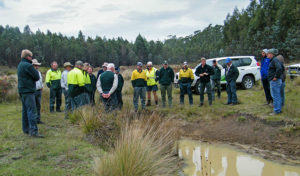Phytophthora Cinnamomi is a fungus that grows inside a susceptible plant’s roots, reducing its ability to transport nutrients to the rest of the tree, killing it or making the tree look sickly (generally known as Dieback).
Trees and plants infect each other by root-to-root contact. However, on a downward slope Phytopthora can travel up to 40 metres per year through soil and mud, and can lay dormant in dry soil.
Some examples of NSW affected areas are Wollemi National Park, Barrington Tops National Park and Mount Imlay National Park where flora and fauna have been radically changed by it. The flora suffering Dieback are quarantined to limit the spread. The infected flora are still important, providing a habitat for species and preventing salinity and erosion in the area.
As bushwalkers, we can play our part when walking nearby infected areas, by assisting in keeping other areas free of infection, limiting the spread and reducing our impact. It’s Sweet to Walk Soft!
Unlike diseases such as Myrtle Rust, studies have found that contaminated trees do not contain the fungus on leaves or branches, but the fungus can still be transported by touching infected roots, water, soil or mud.
Read all signage in our National Parks and follow their instructions, staying out of quarantined areas, as well as using Hygiene Stations when available to brush down gear. Unless with an experienced leader with background training and knowledge in the area, we must stick to tracks and paths while bushwalking and/or driving, and limit the amount of vehicles we take.
To learn more about responsibility in the bush, join your local bushwalking Club, take one of our FREE courses or try volunteering to protect our lovely National Parks.

Notes:
http://www.environment.nsw.gov.au/determinations/PhytophthoraKTPListing.htm
http://www.environment.nsw.gov.au/threatenedspeciesapp/profile.aspx?id=20026
http://www.cpsm-phytophthora.org/
http://barmac.com.au/problem/phytophthora-cinnamomi/

Comments are closed.